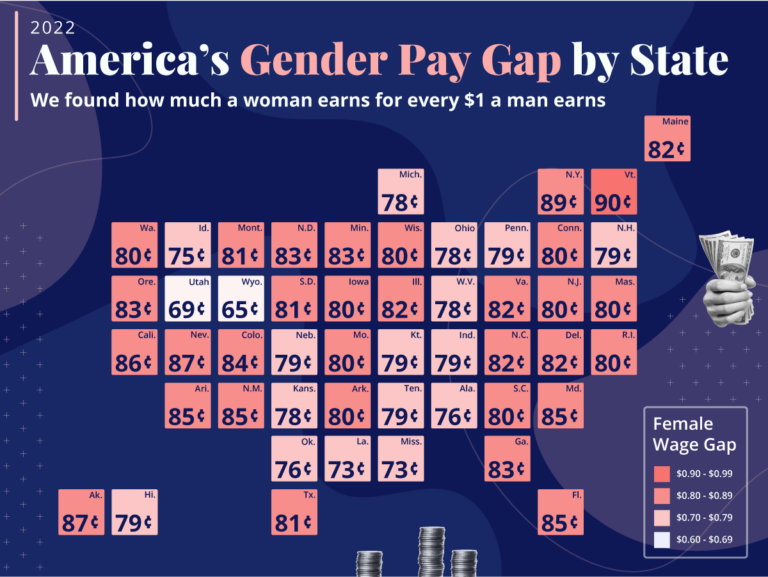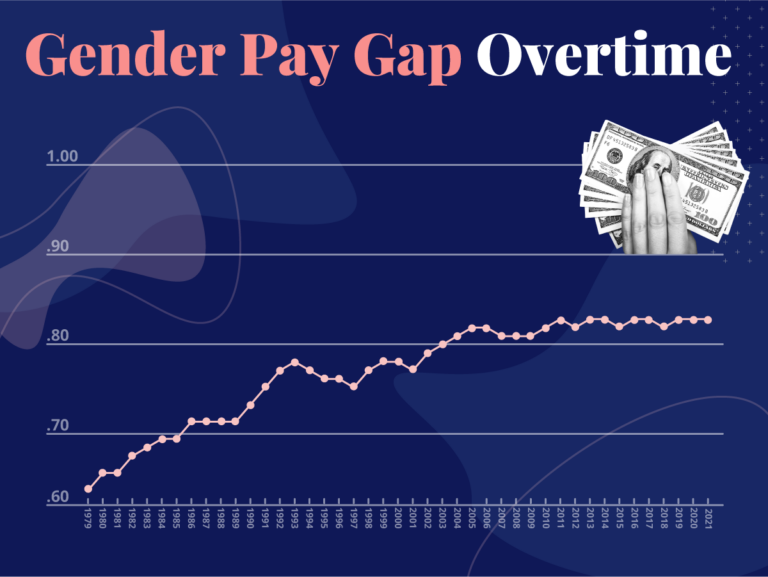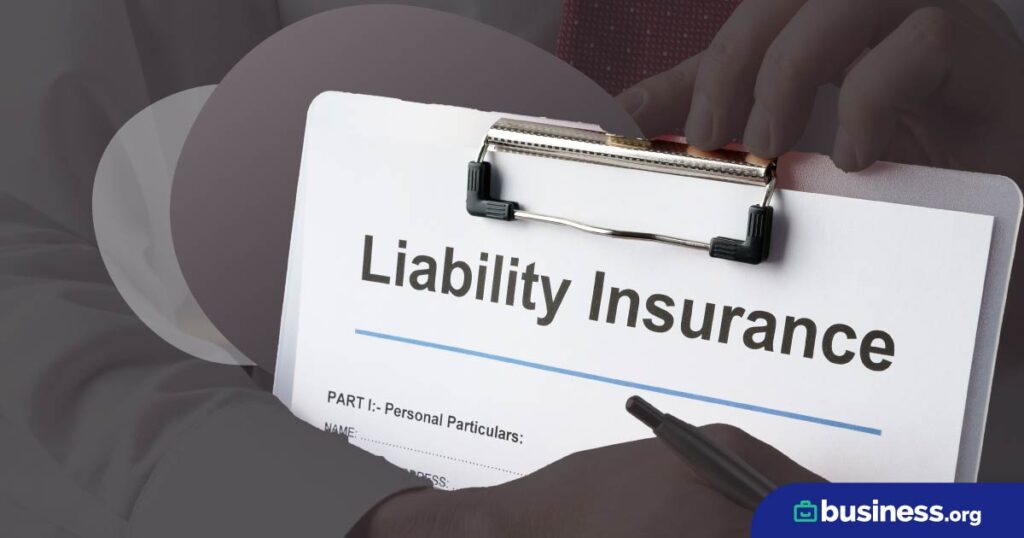We are committed to sharing unbiased reviews. Some of the links on our site are from our partners who compensate us. Read our editorial guidelines and advertising disclosure.
The Gender Pay Gap Across the US in 2022
On average, men will earn $10,381 more in 2022 than women will across the nation.1,2 Excluding Washington, DC, all states have at least a 10% lower median pay for women compared to men.
Using aggregated data from government and academic sources, we’ll compare the smallest and largest gender pay gaps by state and by occupation. States are ranked based on the percentage difference between women’s and men’s earnings for full-time, year-round workers. (Note: The pandemic complicated data collection, which you can read more about in our full methodology.)
We’ll also go over what businesses can do to ensure equal pay, with the hope that the extra expert insight on gender pay discrepancies will help employers and employees close the gap in the coming years.
For women looking to start a business, we can help you find the best grants and small business loans, tips for funding, and payroll software (which can help with your HR needs too!).
America’s gender pay gap shows little progress
If salaries followed working calendar dates (without holidays) in 2022, women effectively stop getting paid on October 29th.3 This means women would work the same amount of time as men the rest of the year and in the same roles essentially without getting paid.
- Since 2010, the wage gap has hovered between 18% and 19% between the salaries of men and women in similar positions, showing little progress across the nation for pay equity.
- The largest wage gap is in Wyoming, where women earn 35% less than men.
- Washington DC has the smallest wage gap, but women still earn 8% less than men.
But do women earn less in every job? According to the Bureau of Labor Statistics, there are only five job roles that report a wage gap favoring women.4
- Compliance officers
- Graphic designers
- Clinical laboratory technologists and technicians
- Pharmacists
- Insurance claims and policy processing clerks
By signing up I agree to the Terms of Use and Privacy Policy.

Even the states with the smallest gender pay gap still face wage gaps ranging from 8.1% to 15.3% between men and women in similar roles, which translates to thousands of dollars missing for women doing the same work.
- Washington, DC, pays women the highest median salary and has the smallest wage gap in the nation at 8.1%; Vermont is the state with the smallest wage gap at 10%.
- The states with the worst wage gaps range from 21.8% to 34.6%; Wyoming has the worst wage gap where women earn only 65.4% of what men earn.
- Women in Mississippi have the lowest median earnings at $34,279. The Magnolia state ranks 48th for its 26.8% gender pay gap.
America’s gender pay gap by state
With the gender pay gap, women in some states effectively work the last few months of the year for free. And, unfortunately, unequal pay for women hasn’t improved by much for more than a decade. Let’s look at how the gender pay gap has changed over time.

The wage gap between men and women remains at nearly 20% for everyone across the country. But, there is hope in a handful of industries.
Top 10 occupations with the smallest pay gaps
Female compliance officers in the US, who ensure government regulations are met, earn up to 7% more than their male counterparts. Other positions that see women being paid more than men in similar positions include graphic designers, pharmacists, clinical laboratory technologists and technicians, clerks, and purchasing agents.
Cashiers, fast food and counter workers, and school bus drivers are close to having near-equal pay for women and men.
Unfortunately, equal (or better) pay is not the reality for most women in virtually all other industries.
Top 10 occupations with the largest pay gaps
The worst wage gaps for women put their earnings at 70% or less of the earnings of men doing the same job.
Securities, commodities, and financial services sales agents (or those who connect buyers and sellers with necessary information), have the worst wage gap at 44%—meaning women in those industries get paid a little over half of what men do. Legal occupations and medical scientists follow, paying women only 60% of what men earn.
According to the Bureau of Labor Statistics, most women work jobs in management, professional, and related occupations, followed by professional and related occupations, and sales and office occupations. These occupations have a wage gap of 24%, 25%, and 21%, respectively.
With most women earning a sizable portion of salary less than men, they effectively stop getting paid by the time November starts. It’s worth considering how our workplaces can help.
Experts have considered various reasons for the gender pay gap. Examples range from women choosing to stay home for family, choosing lower-paying jobs, or having less education. However, other examples point to bias and discrimination, a lack of flexible support for work, and other social factors like racial discrimination.
Here are a few of those examples:
- Education: Pew Research reports that more women have higher educational attainment than men, and women’s higher education level helps close the overall pay gap.5 But comparing equal education levels between men and women shows an even greater gender wage gap. This means working women are more educated than their male counterparts but earn less at equal levels of education.
- Fortunately, that same report says the pandemic did not widen the gender gap.
- We learned from our pay raise survey that the highest percentage of men (31%) responded that they’re willing to ask for a 10%–12% increase, while the highest percentage of women (30%) reported they’re only willing to ask for 6%–9% increases.
- According to Janelle Jones, chief economist for the US Department of Labor, “Many systemic issues are at the root of lower wages for working women—not just gender discrimination, but also racial discrimination, the devaluation of ‘women’s work’, the absence of supports for essential family care, and more.”
- Many argue for an intersectional approach to Equal Pay Day to account for women of color, queer women, and women with disabilities.
Raising awareness around different data may help demonstrate that the wage gap exists beyond personal choices.
How can businesses improve the gender pay gap?
We asked business owners what they do to address pay inequality. The responses mostly revolve around employers reviewing and reporting their employees’ salaries across experience levels, roles, etc, on a regular basis, as well as communicating an open dialogue around salary.
(You can use a payroll calculator to help with salary concerns—and some software offers HR help too).
And even with open dialogue, encouraging fair and proactive pay practices from the get-go can benefit overall employee and business morale.
Gender inequality in pay in the United States may be stagnant, but if small-business owners can take the time to consistently promote a positive pay structure for all employees, we can help close the gender pay gap for more people.
Methodology
States are ranked based on the percentage difference between women’s and men’s earnings for full-time, year-round workers. This data comes from the 2020 American Community Survey (ACS), which ran into significant data sampling issues due to the COVID-19 pandemic.
According to the Census Bureau, the people who did respond to the survey had different social, economic, and housing characteristics than those who did not respond. In particular, low-earning households were much less likely to respond. The bureau has relied on in-person interviews of people residing in group housing quarters, like nursing homes and dorms, to collect data, but this was not possible due to the pandemic. This likely resulted in non-response bias in the data, including in the estimates of marital status, educational attainment, Medicaid coverage, citizenship, income, and poverty.
To address this problem, the Census Bureau used administrative data to weigh data based on other information the bureau has about current population characteristics. It released this experimental ACS data for 2020, which we have used for this analysis.
We used the stop-pay methodology, where stop-pay dates are based on the day of the year women start working for free based on the gender pay gap in that state. These dates are based on a working calendar that omits weekends and rounded up to the nearest day. This calendar does not take holidays into account.
All statistics were calculated by aggregating data from a number of government and academic sources.
Sources
- US Census Bureau, “American Community Survey | S2001 | Earnings in the Past 12 Months (in 2019 Inflation-Adjusted Dollars).” Accessed January 27, 2022.
- US Census Bureau, “2020 ACS 1-Year Experimental Data Tables.” Accessed January 27, 2022.
- Iowa University Human Resources, “Working Day Payroll Calendar, 2022.” Accessed January 27, 2022.
- Bureau of Labor Statistics, “Median Weekly Earnings of Full-Time Wage and Salary Workers by Detailed Occupation and Sex.” Accessed January 27, 2022.
- Pew Research ”During pandemic, some workforce disparities between men, women grew,” January 14, 2022.
- Bureau of Labor Statistics, “Usual Weekly Earnings of Wage and Salary Workers.” Accessed January 27, 2022.
- Bureau of Labor Statistics, “Effects of the Coronavirus COVID-19 Pandemic (CPS).” Accessed January 27, 2022.




